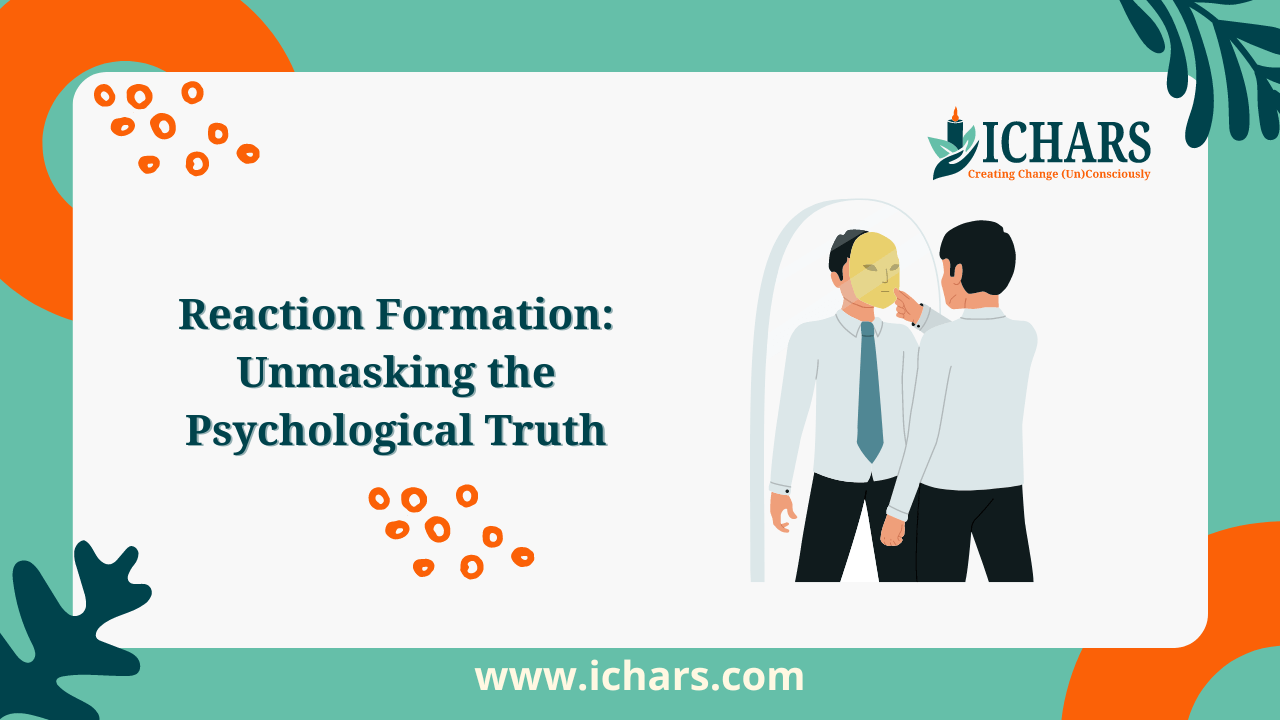You know that feeling when someone is just protesting a little too much about something? Like that overly macho guy who can’t stop bragging about his conquests? Or the self-proclaimed fitness freak who obsessively criticizes anyone overweight? Chances are, you’ve encountered reaction formation in action.
Reaction formation is a fascinating psychological defense mechanism where people essentially convince themselves of the opposite of their true feelings or desires. It’s the mind’s way of avoiding uncomfortable realities by flipping them on their head.
Let me give you an example that really drives this point home. Imagine a politician who has built his entire career railing against same-sex relationships, condemning them as unnatural and immoral at every turn. He’s the poster boy for traditional family values.

But privately, he’s been grappling with his own same-sex attractions for years. His extreme public stance is a classic case of reaction formation – he’s overcompensating for his inner conflicts by adopting an exaggerated opposite belief system.
The tricky part is, people caught in reaction formation genuinely believe their overblown external portrayal. It’s not conscious deception – their psyche has essentially rewritten reality for them as a protection mechanism. That’s what makes it so fascinating from a psychological perspective.
What Exactly is Reaction Formation?
Reaction formation is a defense mechanism where a person suppresses unwanted thoughts, feelings or impulses by behaving in an exaggerated, opposite way. It’s the mind’s clever way of shielding the ego from anxiety or distress caused by these internal conflicts.
This mechanism kicks in when our sense of self feels threatened by certain urges, desires or emotions that clash with our self-image or society’s norms. To cope, our psyche generates an exaggerated stance to counterbalance these unacceptable impulses, leading to hyperbolic or performative behaviour.
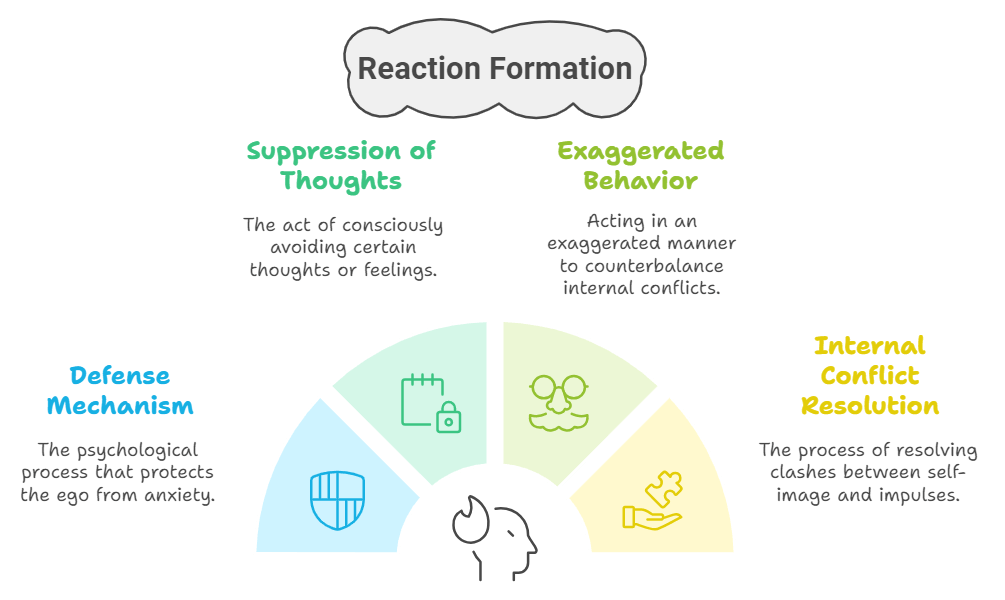
Some everyday examples really highlight how common reaction formation can be. Think of the overly attentive parent who showers their child with affection but internally feels unprepared for parenthood. Or the person who aggressively promotes charitable work to mask their indifference to the cause.
In the workplace, a colleague might excessively praise a peer while secretly feeling envious. These behaviours serve to hide true sentiments from both themselves and others.
The Roots of Reaction Formation
The concept of reaction formation dates back to the early works of Sigmund Freud, who identified it as one of many defense mechanisms the ego uses to manage the id’s unacceptable impulses. Freud’s daughter, Anna Freud, later expanded on this idea, helping us understand the strategies our minds use to maintain psychological balance.
Freud described reaction formation as a way to prevent disturbing thoughts from entering consciousness by exaggerating opposite attitudes and behaviours. He often observed this mechanism in cases related to sexual drives, where patients would oppose what they unconsciously desired.
While other psychologists like Carl Jung touched on similar behaviours, contemporary psychology views reaction formation through various lenses, including behavioural, cognitive, and social psychology, recognizing its complexity and variability.
The Many Faces of Reaction Formation
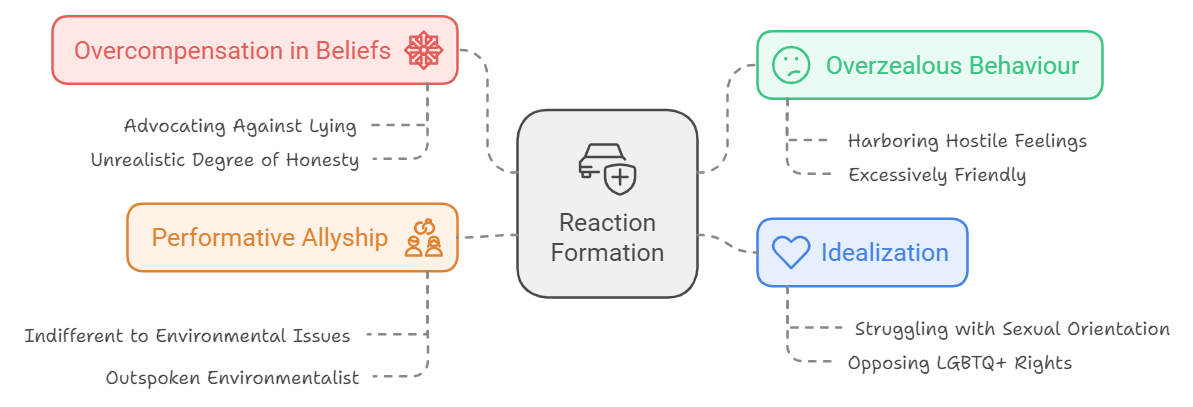
Reaction formation can take on several forms, each with unique patterns and contexts. Here are a few common subtypes with examples:
- Overcompensation in Beliefs: Someone insecure about their honesty might become an outspoken advocate against lying, often to an unrealistic degree.
- Overzealous Behaviour: A person harboring hostile feelings may become excessively friendly or helpful to mask their true sentiments.
- Idealization: Someone struggling with their sexual orientation might vehemently oppose LGBTQ+ rights, promoting heterosexual norms excessively.
- Performative Allyship: An individual indifferent to environmental issues might publicly become an outspoken environmentalist.
The Pros and Cons of Reaction Formation

Despite its drawbacks, reaction formation can initially serve a protective role for the psyche:
- Maintaining Psychological Stability: It helps keep distressing emotions at bay, allowing for psychological equilibrium.
- Aligning with Societal Expectations: It aids in conforming to societal norms, crucial for social integration and acceptance.
- Coping with Inner Turmoil: It provides temporary relief from emotional turmoil without confronting underlying issues.
- Self-Regulation and Control: It offers a sense of control over undesirable emotions or impulses.
- Avoidance of Painful Realizations: It shields the ego from painful self-realizations, protecting self-esteem.
However, long-term reliance on reaction formation can lead to significant personal and interpersonal issues:
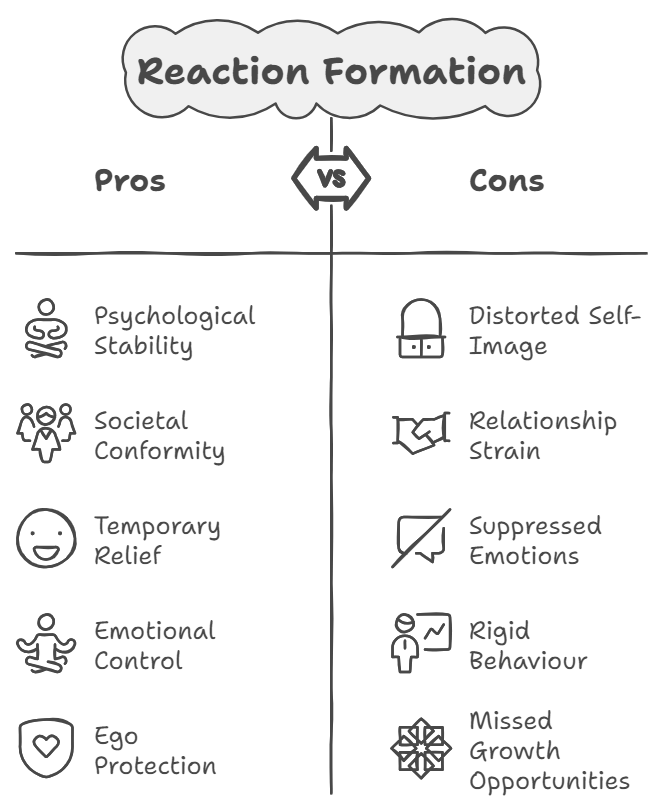
- Distorted Self-Image: It creates a dissonance between one’s true feelings and projected behaviour, leading to a sense of inauthenticity.
- Relationship Strain: The lack of transparency can breed mistrust and tension in relationships.
- Suppressed Emotions: Unaddressed emotions can resurface unexpectedly, causing stress and psychological issues.
- Rigid Behaviour: Overcompensating behaviours become entrenched, limiting flexibility in different situations.
- Missed Opportunities for Growth: Avoiding uncomfortable emotions prevents personal growth and self-understanding.
- Mental Health Concerns: Chronic use can contribute to anxiety and depression due to the internal conflict between actions and feelings.
Navigating Reaction Formation in Therapy
In the therapy room, reaction formation poses unique challenges as clients might not even be aware of this defense mechanism at play. They may genuinely believe in their exaggerated behaviours, making it difficult to address the underlying issues. This rigid exterior can act as a barrier, preventing clients from accessing and expressing authentic emotions.
As therapists, a sensitive and patient approach is crucial to help clients navigate reaction formation:

- Building Trust: Establishing a strong therapeutic alliance helps clients feel safe enough to explore uncomfortable aspects of their psyche.
- Gradual Exposure: Guiding clients through a gradual process of self-discovery can help them recognize the discrepancy between their behaviours and true feelings.
- Reflective Techniques: Approaches like reflecting feelings and experiences can help clients see the incongruence in their actions and attitudes without directly challenging their defenses.
- Psychoeducation: Educating clients about defense mechanisms like reaction formation can sometimes allow them to recognize these patterns in a new light.
Overcoming Reaction Formation with Cognitive Hypnotic Psychotherapy
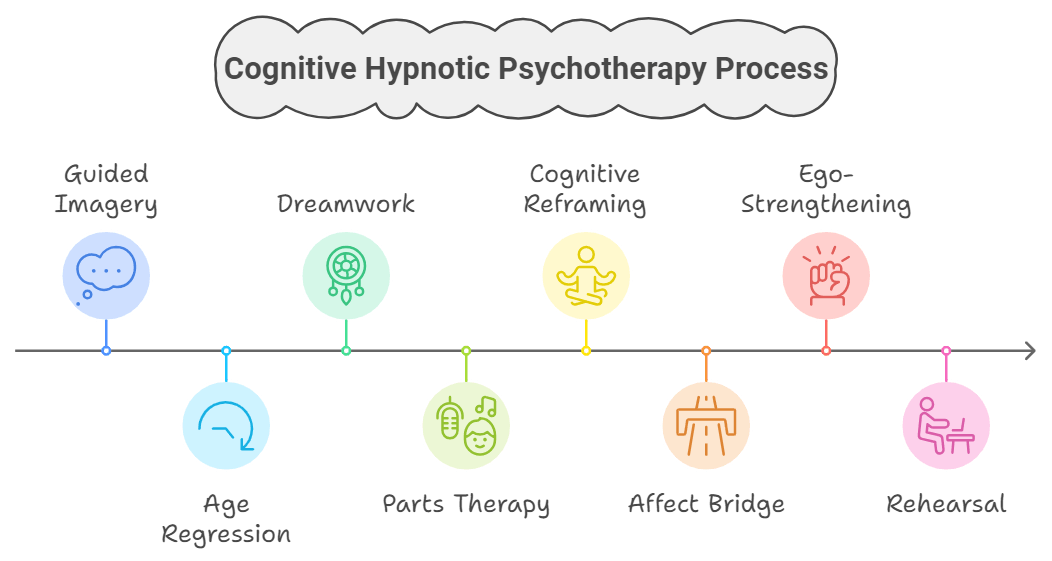
One powerful approach to help clients dismantle reaction formation is Cognitive Hypnotic Psychotherapy (CHP). This integrative model uses hypnosis to uncover and address unconscious patterns driving behaviours like reaction formation. Here’s a step-by-step guide:
- Guided Imagery: Hypnotic guided imagery can explore situations where the client might be using reaction formation safely.
- Age Regression: Through hypnotic age regression, you can revisit earlier experiences that may have led to developing this defense mechanism.
- Dreamwork: Analyzing dreams for symbolic representations of reaction formation and underlying feelings can offer insights.
- Parts Therapy: Use parts therapy to have different parts of the client’s psyche voice their true feelings and the reaction formation separately.
- Cognitive Reframing: Help the client reframe and accept underlying feelings as normal and natural, reducing the need for reaction formation.
- Affect Bridge: Build an affect bridge between the conscious reactive feelings and the unconscious opposite feelings.
- Ego-Strengthening: Use hypnotic suggestions for increased self-acceptance to reduce defensiveness.
- Rehearsal: Rehearse desired responses through hypnotic mental practice when triggering situations arise.
The Path to Authenticity
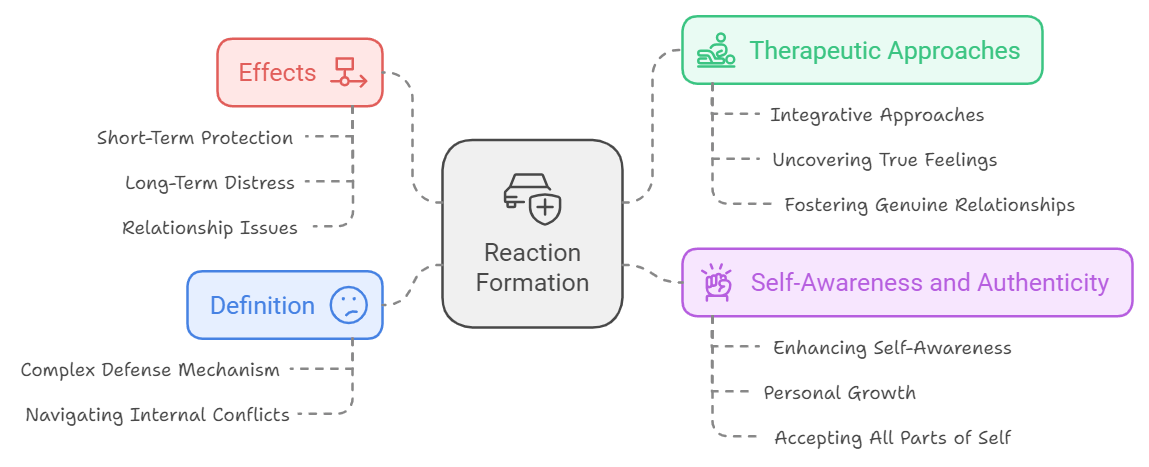
Reaction formation is a complex defense mechanism that helps us navigate internal conflicts by exaggerating opposite behaviours and attitudes. While it can protect us in the short term, it often leads to greater psychological distress and relationship issues in the long run.
Understanding and addressing reaction formation through therapy, particularly integrative approaches like Cognitive Hypnotic Psychotherapy, can help individuals uncover their true feelings and lead more authentic lives. By dismantling this mechanism, we can foster genuine relationships, enhance self-awareness, and embrace personal growth.
Remember, all defense mechanisms serve a purpose in our mental operations initially. The key lies in developing the self-awareness and courage to face the truths beneath our psychological armor when they start hindering our wellbeing.
Because at the end of the day, there’s nothing more liberating than being able to accept all parts of ourselves without judgment. Isn’t that what we all deserve?
